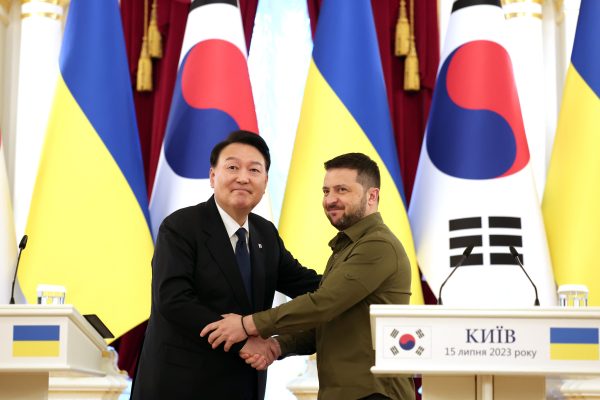Ukraine is betting on land robots and seeking billions more in investment to boost its domestic weapons manufacturing, Ukraine’s top official in charge of defense production efforts said Tuesday during a briefing to reporters on the sidelines of the NATO summit.
“This year will be the year of [unmanned] land systems,” said Oleksandr Kamyshin, Ukraine’s minister for strategic industries of Ukraine. “You’ll see more of them on the frontline” over the next 12 months, he said.
Land systems would be used for medical evacuation, logistics, de-mining, and mining, as well as other combat tasks, Kamyshin said.
As Ukraine seeks to use ever more sophisticated weapons to counter Russia, it first needs to find the investments necessary to ramp up production, Kamyshin added.
Kamyshin, speaking at the opening of the U.S. office of the state-owned defense conglomerate Ukrainian Defense Industry, said he is seeking a further $10 to 15 billion in investments in the Ukrainian weapons industry.
The U.S. State Department in May announced a grant of $2 billion dollars for Ukraine, part of which will go to Ukrainian industry. And that investment is helpful, Kamyshin said, noting the country received similar aid from Denmark.
The money could lead to major upgrades in Ukraine’s defense industrial capacity, Kamyishin said. For example, if one producer can currently make tens of drones, with enough funding they could scale up to hundreds, he said. “Ukrainian producers are quite hard working,” he said.
The Ukrainian Defense Industry conglomeration is already working with a number of U.S. companies on joint production, according to a presentation at the group’s office.
The presentation slides named a number of companies as involved in current or potential projects. Northop Grumman was listed as working on joint production of munitions and the “development of a special chemicals plant.” Day and Zimmerman were also listed as partners on joint production of munitions, while D&M Holdings was listed as collaborating on the production of propellent charges and primers.
Other partners include Leonardo, identified as working on the “integration of laser technology into Ukrainian air defense systems” and Amentum, which is working on a joint enterprise and the maintenance of armored vehicles.
Kamyshin declined to answer questions about Ukraine’s 155m production capacity, either current or planned. However, he did note a lack of investment and energetics as limiting production. Russian attacks are also a problem, Kamyshin said, with Russia launching around two attacks per week on Ukrainian defense producers.
A Ukrainian push to produce more drones domestically has seen success, Kamyshin added. Ukraine can now make millions of FPV drones, tens of thousands of mid-range drones, and thousands of long-range strike drones, he said.
Now, the task is to refine drone production, Kamyshin said. “This year is the year of coordination,” he said, adding that Ukrainians have been using artificial intelligence for targeting and will likely increase their use of AI over the next 12 months.
Ukraine’s move to produce more weapons domestically comes amid mixed results from its allies in ramping up munitions production. While the U.S. is on track to produce 1.2 million rounds a year of 155mm shells starting next summer, capacity across the EU stands at around 500,000 rounds per year.
Estonian Defense Minister Hanno Pevkur, speaking at the Estonian embassy also on Tuesday, said he is “mostly happy,” with production increases, even though there is still room for improvement. One limiting factor, he said, is the year or more it can take to set up new munitions plants because of local regulations.
A panel of munitions firms executives speaking at a U.S. Chamber of Commerce event pointed out one more problem for European producers—one not likely to be shared by Ukrainian manufacturers, who are already two years deep into their defense against Russia’s full-scale invasion.
“What we are missing so far—at least partly—is a long term predictability,” or contracts from NATO member nations, said Thomas Gottschild, CEO of MBDA Germany. “We still need to work on that.”





















Discussion about this post